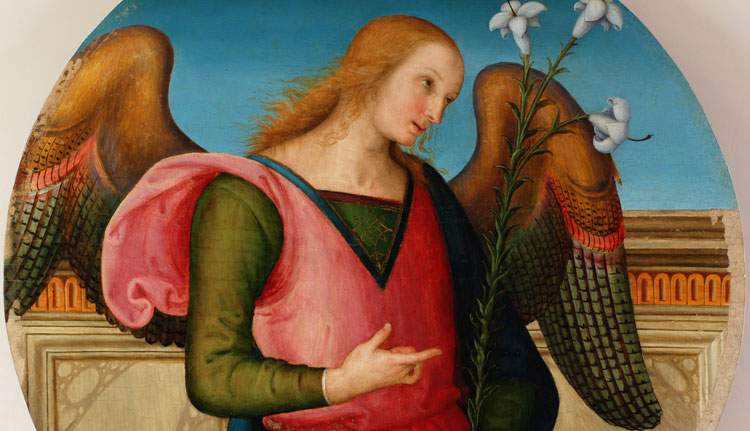After the exhibition Raphael and Baldassare Castiglione, the Ducal Palace of Urbino is dedicating a new show to a master of the Italian Renaissance, Pietro Vannucci known as Perugino (Città della Pieve, c. 1448 - Fontignano, 1523): this is the exhibition Perugino, Raphael’s Master, which finds space in the Palace’s Sale del Castellare from July 20 to October 17, 2021. The exhibition is a lunge into the refined art of Perugino, an artist who knew how to fuse with extraordinary harmony the best prerogatives of Central Italian painting of the second half of the 15th century and exerted a great influence on the young Raphael.
The result of a collaboration between the Galleria Nazionale delle Marche, the Marche Region and the Municipality of Urbino, curated by Vittorio Sgarbi and organized by Civita Mostre e Musei and Maggioli Cultura, the exhibition ideally completes the celebrations for the fifth centenary of Raphael’s death and anticipates the fifth centenary of Perugino’s death that will be celebrated in 2023. The exhibition addresses, through some 20 works, one of the highest moments in the history of Renaissance art: indeed, Perugino is one of the greatest masters of his time, and after leading the construction site of the Sistine Chapel, he is by far the highest-rated artist. But the exhibition aims to capture a particular moment in his artistic career, when the balances of the 15th century are behind him and Perugino is at the height of his career, when the precocious genius of the young Raphael emerges in his own workshop.
The exhibition opens with the works of a number of Umbrian and Marche artists, including Giovanni Boccati and Bartolomeo Caporali, to recall the figurative context of the second half of the 15th century, where the flashes of the late Gothic period are still felt and in which Perugino’s early artistic training moves. But his horizon soon shifted to Florence, to the workshop of Andrea del Verrocchio, at that time frequented by the most promising talents in Florentine painting, including Leonardo, Botticelli and Ghirlandaio. It was by virtue of this prestigious apprenticeship that Perugino acquired the enviable fluency of drawing that would later be the basis of his art. In Florence it was also possible to admire the masterpieces of the most celebrated Flemish masters, which Perugino always tried to emulate, especially in his luminous and enameled landscapes. No less important for his training was his encounter with Piero della Francesca, who transmitted to him a more measured sense of composition and a perfect competence in perspective. In 1481 he was called to direct, along with other artists, the decoration of the Sistine Chapel, an undertaking that would mark a decisive turning point in his career. The master managed for at least two decades to enjoy undisputed success and to attract commissions from all parts of Italy, to the point of keeping no less than two workshops in Florence and Perugia.
With loans from the National Gallery of Umbria, the Museum of Ancient and Sacred Art in Sutri, the Museum of the Treasure of the Basilica of San Francesco in Assisi, as well as the Galleria Nazionale delle Marche in Urbino itself, the exhibition begins with an initial section devoted to the artists who preceded Perugino, highlighting the extraordinary unity of artistic language between the two “sides” of the Umbrian and Marche Apennines, a sign of a time when the mountain was not a barrier but rather a factor of unity in art and beyond. In the second exhibition room, Perugino’s work is evoked through the works of his “colleagues” such as Giovanni Santi, Bartolomeo della Gatta, Pinturicchio and Luca Signorelli, the latter partly also his pupils. The third section presents the most important nucleus of Perugino’s works, created between the 15th and 16th centuries, before Raphael moved to Florence and for Perugino began instead a season more bent toward his own territory. The final room is devoted to Perugino’s legacy and thus to the artists who interpreted his lesson, giving rise to a manner that spread beyond the Umbrian-Marches borders. Perugino in fact created a national language (anticipating in this Raphael and for the first time after Giotto) from which derives a kind of Peruginesque “mannerism” that determined his “Italian” fortune.
The narrative journey is enriched by two video contributions. The first film compares Perugino’s Sposalizio della Vergine, painted in the early 16th century for Perugia cathedral and now in the Musée des Beaux Arts in Caen, Normandy, with Raphael’s Sposalizio della Vergine, the panel painted in 1504 for the church of San Francesco in Città di Castello and now in the Pinacoteca di Brera. Starting with the Handing over of the Keys, frescoed by Perugino in the Sistine Chapel between 1481 and 1482 and the frescoes in the Collegio del Cambio in Perugia, the film highlights the “debt” to Perugino and at the same time the “overtaking” already accomplished by the young Raphael. A second video allows visitors to trace the artistic production of Perugino’s maturity through a selection of twenty masterpieces. Finally, the exhibition is accompanied by a scholarly catalog published by Maggioli Cultura.
Hours: Mondays from 10 a.m. to 2 p.m., Tuesdays to Sundays from 10 a.m. to 6 p.m. Tickets: 8 euros full price, 2 euros reduced 18-25 years old and over 65. Cumulative exhibition+National Gallery: 12 euros full, 3 euros reduced.
 |
| Perugino stars in an exhibition at Urbino's Ducal Palace curated by Vittorio Sgarbi |
Warning: the translation into English of the original Italian article was created using automatic tools. We undertake to review all articles, but we do not guarantee the total absence of inaccuracies in the translation due to the program. You can find the original by clicking on the ITA button. If you find any mistake,please contact us.